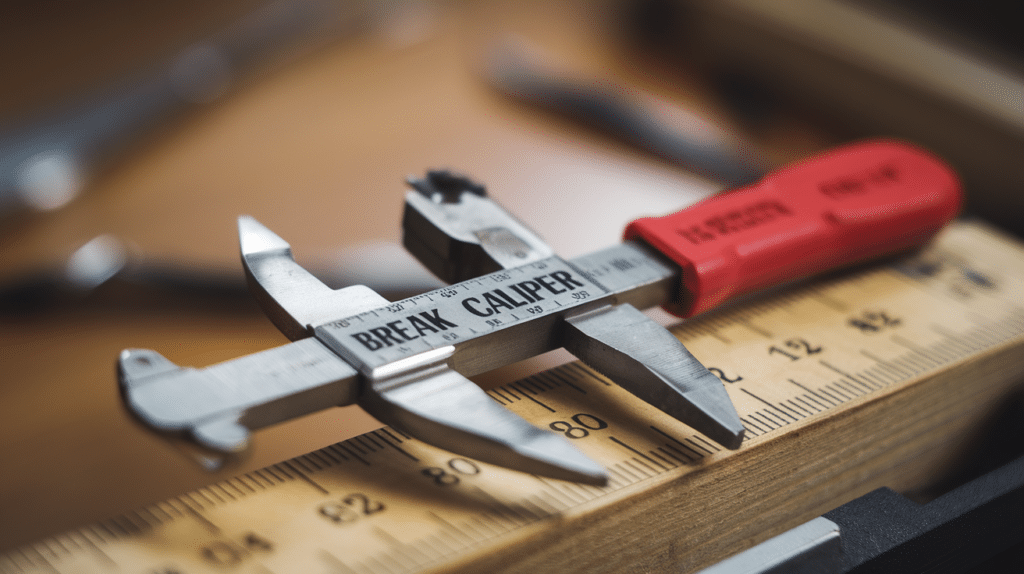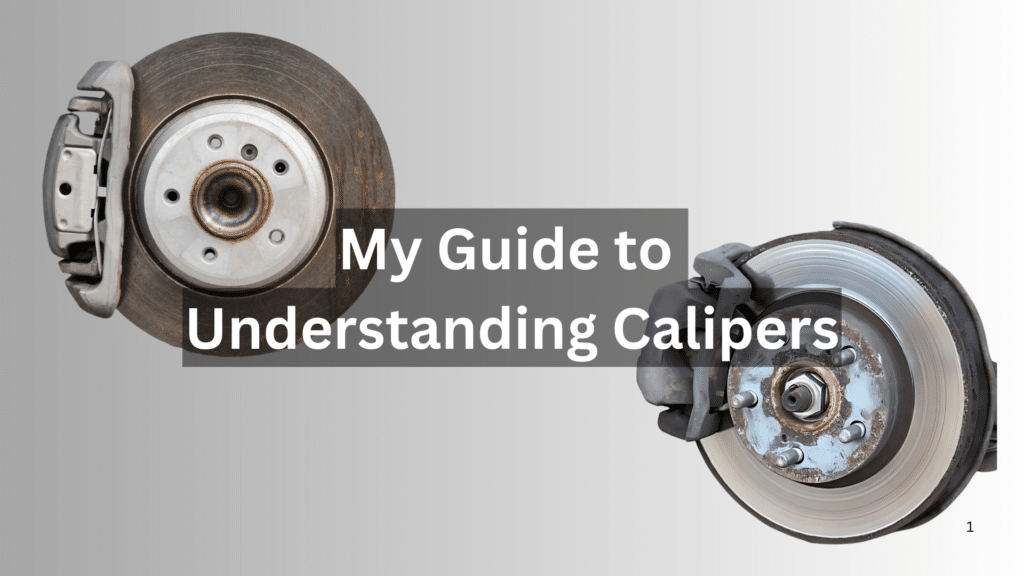Are your brakes making strange noises? Do you feel your car pulling to one side when you stop? Your calipers might be the problem.
In this article, I’ll explain everything about brake calipers – what they are, how they work, and when they fail. As a mechanic with 15 years of experience, I’ve seen countless brake problems that could have been avoided with basic knowledge.
You’ll discover:
- The different types of calipers and when each is used
- Warning signs that your calipers are failing
- Simple maintenance tips to extend their life
- How to know when replacement is necessary
No more guessing or overpaying for brake repairs. By the end of this article, you’ll understand this critical component and make smarter decisions about your vehicle’s maintenance.
Your safety on the road depends on good brakes. Let me help you keep them working perfectly.
What is a Caliper?

A caliper is a vital part of your disc brake system. Think of it as a clamp that squeezes your brake pads against the rotor. When this happens, friction occurs, slowing down your wheels and stopping your car.
That’s it. Simple, right?
But without this small component, your car would keep rolling no matter how hard you pressed the brake pedal. Pretty important, wouldn’t you say?
How Does a Caliper Work?
A caliper plays a key role in your vehicle’s braking system. It applies pressure to the brake pads, helping stop your car when you apply the brakes.
Here’s how your brake calipers work in five easy steps:
- You press the brake pedal
- Brake fluid gets pushed through the lines
- This fluid creates pressure inside the caliper
- The pressure forces a piston (or pistons) to move
- The pistons push the brake pads against the rotor
The harder you push, the more pressure builds up. More pressure means more stopping power.
It’s like squeezing an orange. Apply light pressure, and a little juice comes out. Squeeze harder, and you get more juice. Your brake system works similarly, just with hydraulic fluid instead of orange juice!
Types of Calipers
The caliper is essential in ensuring the safety and performance of car brakes. Different types of calipers are designed to suit specific braking needs.
Let’s break down the main types:
Single-Piston Calipers
These have just one piston that pushes the brake pad.
They are:
- Simpler in design with fewer moving parts
- Less expensive to manufacture and replace
- Common on older cars and rear brakes of many economy vehicles
- Good enough for regular driving with moderate stopping needs
- Lighter weight, which helps with fuel economy
Single-piston calipers work well for everyday driving but may not provide enough stopping power for performance driving or heavy loads.
Multi-Piston Calipers
These advanced calipers have two, four, or even six pistons.
You’ll find them on:
- Sports cars and performance vehicles
- Heavy trucks and SUVs
- Front brakes of many modern mid-range and luxury vehicles
- Vehicles that tow or carry heavy loads
Two-piston calipers provide more even pressure than single-piston designs. They’re common on midsize sedans and small SUVs.
Four-piston calipers distribute pressure across the entire pad surface, reducing heat and improving performance during hard braking. Many sports cars and larger vehicles use these.
Six or eight-piston calipers are premium options found on high-performance and luxury vehicles. They provide the most even pad wear and the best heat management during extreme braking.
Why so many pistons? More pistons spread pressure evenly across the brake pad. This means better-stopping power, less heat buildup, and more consistent performance.
Fixed vs. Floating Calipers
Fixed calipers don’t move relative to the rotor. They have pistons on both sides that squeeze from two directions.
These offer:
- Better performance with direct pressure from both sides
- More rigid construction with less flex during hard braking
- Improved heat dissipation for consistent performance
- Higher cost and weight
- More complex design for repairs
Fixed calipers are common on sports cars, performance vehicles, and premium brands like BMW, Porsche, and Audi.
Floating calipers (sliding calipers) move slightly on pins or slides. They have pistons on only one side. When the pistons push out, the entire caliper slides to bring the other pad in contact with the rotor.
These provide:
- More affordable manufacturing and replacement costs
- Simpler design that’s easier to service
- Self-centering capability as the caliper “floats” into position
- Lighter weight than comparable fixed designs
- Good performance for everyday driving conditions
Floating calipers are found on most economy cars, family sedans, and many SUVs.
Other Specialized Types
Opposed-piston calipers have pistons on both sides of the rotor working in opposition. These high-performance designs provide the most even clamping force.
Electro-mechanical calipers are newer designs used in some hybrid and electric vehicles. They combine traditional hydraulic systems with electric motors for better efficiency and integration with regenerative braking.
Each type has its place depending on your vehicle’s design, weight, and performance needs.
Common Materials Used for Calipers
Calipers need to be tough. They face extreme heat and pressure every day. Regarding brake calipers, the materials used play a crucial role in performance and durability.
Common materials include cast iron, aluminum, and carbon composite, each offering distinct benefits for different driving needs.
The most common materials are:
- Cast iron – Durable and cheap, but heavy
- Aluminum – Lighter weight, helps with fuel economy
- High-strength steel – Strong and resistant to warping
Performance calipers might use exotic materials like billet aluminum or carbon fiber components. These aren’t just for show – they help manage heat and reduce weight.
Signs of a Failing Caliper
Your car will talk to you when calipers start to fail. You need to listen. If your car’s brakes aren’t working as they should, a failing caliper might be the cause. Knowing the signs can help you catch the issue early before it becomes a bigger problem.
Watch out for these warning signs:
- Pulling to one side when braking
- Unusual noises (squealing, grinding, or clunking)
- Leaking fluid near your wheels
- Uneven brake pad wear
- Brake warning light on your dashboard
- Stuck brake pedal that feels hard to press
Don’t ignore these signals! A failing caliper can lead to complete brake failure or expensive damage to other parts.
How to Maintain Your Caliper
Maintaining your caliper is crucial for ensuring your braking system works effectively and lasts longer. Good news! Calipers don’t need much maintenance.
Regular care can help you avoid costly repairs and keep your vehicle running safely.
Here’s what you can do to keep them happy:
- Check for leaks regularly. Look for wet spots or drips around your wheels.
- Clean your calipers when you wash your car. Dirt and road grime can cause sliding parts to stick.
- Bleed your brakes according to your car’s maintenance schedule. This removes air bubbles that reduce braking efficiency.
- Use your brakes properly. Avoid riding the brakes downhill for long periods, which creates excessive heat.
- Replace brake fluid every 2-3 years. Old fluid absorbs moisture and can corrode your calipers from the inside.
These simple steps will help your calipers last longer. Your wallet will thank you!
When to Replace a Caliper
Even the best calipers eventually wear out. Your car’s brake calipers are crucial in ensuring safe and smooth braking, and knowing when to replace them is important for maintaining your vehicle’s safety and performance.
Here’s when to consider replacement:
- When you see leaking brake fluid
- If the caliper sticks or freezes
- When pistons won’t retract properly
- If there’s significant corrosion
- When rebuild kits don’t fix the problem
Sometimes, you must replace calipers in pairs (both left and right) to ensure even braking. This isn’t always necessary, but your mechanic might recommend it.
Conclusion
Brake calipers might seem complicated, but now you understand their importance. These small parts make a big difference in your safety on the road.
Next time you hear a strange noise when braking or feel your car pulling to one side, you’ll know what might be happening. This knowledge puts you in control.
Remember these key points:
- Check for leaks regularly
- Listen for unusual noises
- Don’t ignore warning signs
- Maintain your brake fluid
I’ve seen too many preventable brake failures in my career. With the information from this article, you won’t be one of those stories.
Take care of your calipers, and they’ll take care of you. Your family’s safety is worth this small bit of attention.
Questions? Your mechanic is just a call away.
Frequently Asked Questions
Can I Drive with A Bad Caliper?
No, it’s not safe to drive with a bad caliper. You might lose braking power or damage other parts of your car.
How Much Does It Cost to Replace a Caliper?
Caliper replacement typically costs between $150 and $400 per caliper. At most shops, this price includes parts and labor.
Can I Replace a Caliper Myself?
Yes, if you have basic tools and mechanical skills. Afterward, you’ll need to bleed the brakes properly.
How Long Do Brake Calipers Usually Last?
Most calipers last about 75,000 to 100,000 miles. With good maintenance, they can last even longer.
Why Is My Caliper Sticking?
Calipers stick when dirt gets in, or parts corrode. Old brake fluid can also cause sticky calipers over time.


